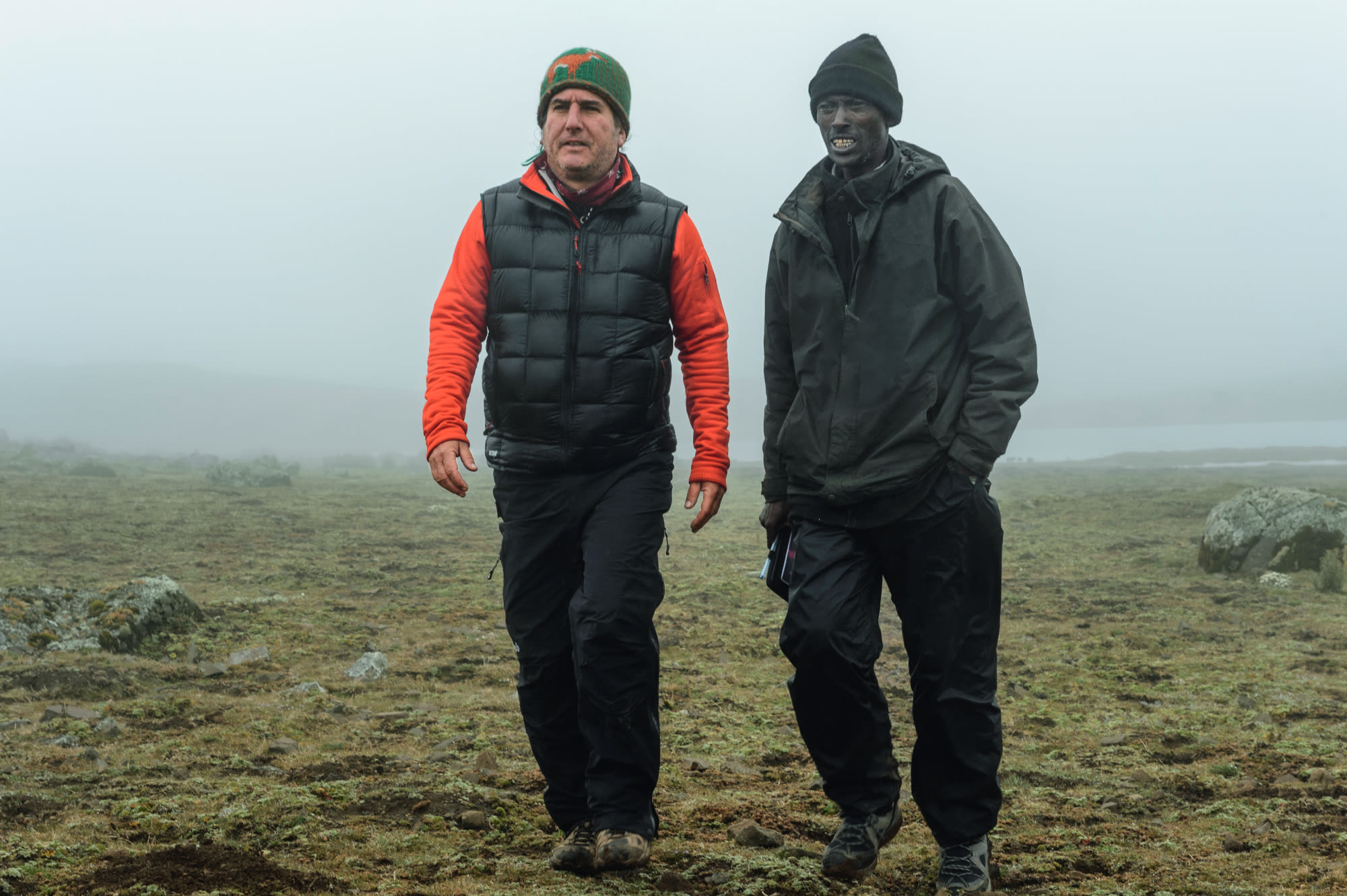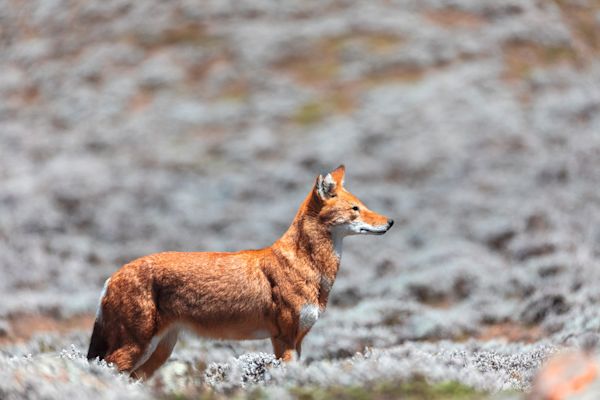Red-hot Poker flowers smolder yellow and red like fiery embers. An isolated thunderstorm drifts across a distant ridgeline. Windswept, thick-stalked Giant Lobelia plants (also known as Tree Lobelias) defy the gusting currents that whip across the plateau. Everlasting Helichrysum bushes swirl like the undulating texture of rough seas.
It’s windy on the Roof of Africa at over 4,000 meters above sea level. At first glance, the environment appears barren, but looks can be deceiving: Measured in biomass, the Afromontane highlands of the Sanetti Plateau in Ethiopia’s Bale Mountains National Park are every bit as productive as savannah grasslands found elsewhere in Africa. Rodent species like the Giant Molerat and Grass Rats thrive below ground, forming the foundation of a complex food chain. Somewhere in this churning, windblown carpet of low vegetation and weathered rock, the world’s rarest canid, Africa’s most threatened carnivore, searches for a meal hiding just beneath the surface: the Ethiopian Wolf.
Claudio Sillero, Professor of Conservation Biology at the University of Oxford and Chief Scientist at the Born Free Foundation, first arrived in the Bale Mountains as a graduate student in 1987. He immediately knew: “These animals need a champion.”
A sustainable future for the Ethiopian Wolf
The story of the Ethiopian Wolf is not unlike the country itself: flourishing in a space that is all its own yet bearing the brunt of pressures such as population growth, habitat encroachment, and unsustainable natural resource use. “When I first started working with the wolves, I was surprised just how little people in cities knew about them, beyond that they were featured on a postage stamp,” says Sillero. In 1995, he founded the Ethiopian Wolf Conservation Programme (EWCP) in cooperation with local authorities, establishing a vision for a sustainable future for all remaining populations of Ethiopian Wolf.

The chief threat: Rabies and canine distemper virus
Rufous and earthen with a white underside, the Ethiopian Wolf cruises low between shrubs and boulders in search of prey. Active during the day, the wolves can often be observed from the high-elevation road that stretches across the Sanetti Plateau. The wolf range has continued to shrink in the last 30 years and today, this Afroalpine top predator numbers some 500 individuals. Habitat loss alone, however, is not the chief threat: The arrival of livestock and with them domestic dogs, which transmit viruses such as rabies and canine distemper virus, have had a devastating effect on the population. That they still survive here in this fragile environment is thanks to the efforts of Prof. Sillero, his wife and project partner Dr. Jorgelina Marino, and the dedicated EWCP conservation team.
Sillero and his team have worked tirelessly to vaccinate both local dogs and the wolves themselves, a project that has taken years to yield stability. “Protecting the wolves also allows us to protect these incredible landscapes, referred to as the Roof of Africa, which are unique to the highlands of Ethiopia,” says Sillero. Bale Mountains National Park is also home to a range of endemic mammals, birds, and plants specialized to live in this environment.


© Marielle van Uitert
The protection of nature and biodiversity is core to SWAROVSKI OPTIK’s company philosophy. We are currently supporting the EWCP, empowering them to vaccinate at least 1.000 dogs in and around Bale Mountains National Park in Ethiopia and helping to protect the wolves against deadly rabies infections. In addition, the EWCP wolf monitors now have 15 pairs of SWAROVSKI OPTIK binoculars for their daily work protecting this endangered species.

© Marielle van Uitert
Ethiopian wolves are Africa’s rarest carnivore, found only in the Ethiopian highlands where they live close to shepherds, their livestock and their dogs. Many of these dogs roam around in the mountains looking for food, and pose a risk to the wolves as vectors of rabies and distemper.

OBSERVING THE ETHIOPIAN WOLF
IN A RESPONSIBLE MANNER
Make contributing to the survival of the Ethiopian Wolf a part of your trip planning and preparation!
Focus on local initiatives to ensure that the money you spend stays in local communities. Consider horseback riding in Bale Mountains or visit the Guassa Community Conservation Area for a truly authentic community-based tourism enterprise.
Consider integrating a contribution to the survival of the Ethiopian Wolf into your travel budget by donating before you head to Ethiopia. Donations can be made to the Wildlife Conservation Network (USA), the Born Free Foundation (UK), or the IUCN Canid Specialist Group via www.ethiopianwolf.org

About the
Ethiopian Wolf
The endemic Ethiopian Wolf is a specialist predator found only in the highlands of Ethiopia. Largely a diurnal, solo hunter, it preys upon small mammals such as Grass Rats, the Giant Molerat, Starkii Hare and Rock Hyrax before returning to its pack in the evening to socialize. Ethiopian Wolves are restricted to just six isolated highland areas and have a world total population of approximately 500 adult animals. There are no Ethiopian Wolves kept in captivity. They are threatened by rapidly expanding subsistence farming and cattle grazing as well as diseases such as rabies and the canine distemper virus, that are transmitted by domestic dogs.

About the
EWCP
The Ethiopian Wolf Conservation Programme (EWCP) was founded in 1995. Its mission is to protect and ensure the future of one of the world’s rarest canid species and most threatened African carnivore by protecting the population in the Bale Mountains and other threatened, smaller populations living in suitable mountain ranges on either side of the Great Rift Valley habitat. Protecting the wolves safeguards the future of endemic Afroalpine species while protecting natural resources vital to human livelihoods.
















